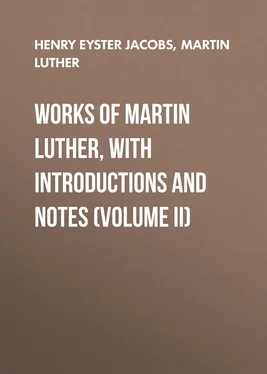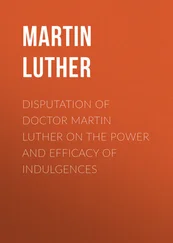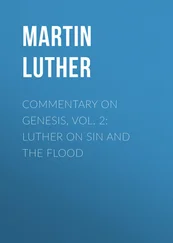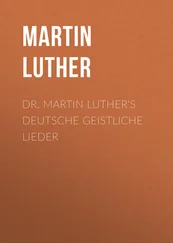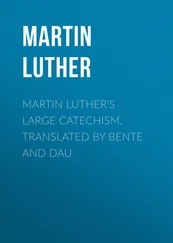Henry Eyster Jacobs - Works of Martin Luther, with Introductions and Notes (Volume II)
Здесь есть возможность читать онлайн «Henry Eyster Jacobs - Works of Martin Luther, with Introductions and Notes (Volume II)» — ознакомительный отрывок электронной книги совершенно бесплатно, а после прочтения отрывка купить полную версию. В некоторых случаях можно слушать аудио, скачать через торрент в формате fb2 и присутствует краткое содержание. Жанр: foreign_prose, foreign_religion, Философия, foreign_psychology, foreign_antique, на немецком языке. Описание произведения, (предисловие) а так же отзывы посетителей доступны на портале библиотеки ЛибКат.
- Название:Works of Martin Luther, with Introductions and Notes (Volume II)
- Автор:
- Жанр:
- Год:неизвестен
- ISBN:нет данных
- Рейтинг книги:3 / 5. Голосов: 1
-
Избранное:Добавить в избранное
- Отзывы:
-
Ваша оценка:
- 60
- 1
- 2
- 3
- 4
- 5
Works of Martin Luther, with Introductions and Notes (Volume II): краткое содержание, описание и аннотация
Предлагаем к чтению аннотацию, описание, краткое содержание или предисловие (зависит от того, что написал сам автор книги «Works of Martin Luther, with Introductions and Notes (Volume II)»). Если вы не нашли необходимую информацию о книге — напишите в комментариях, мы постараемся отыскать её.
Works of Martin Luther, with Introductions and Notes (Volume II) — читать онлайн ознакомительный отрывок
Ниже представлен текст книги, разбитый по страницам. Система сохранения места последней прочитанной страницы, позволяет с удобством читать онлайн бесплатно книгу «Works of Martin Luther, with Introductions and Notes (Volume II)», без необходимости каждый раз заново искать на чём Вы остановились. Поставьте закладку, и сможете в любой момент перейти на страницу, на которой закончили чтение.
Интервал:
Закладка:
124
The statement of which Luther here complains is found in the Decretum of Gratian, Dist. XL, c. 6, Si papa . In his Epitome (see Introduction, p. 58), Prierias had quoted this canon against Luther, as follows: " A Pontifex indubitatus (i. e., a pope who is not accused of heresy or schism) cannot lawfully be deposed or judged either by a council or by the whole world, even if he is so scandalous as to lead people with him by crowds into the possession of hell." Luther's comment is: "Be astonished, O heaven; shudder, O earth! Behold, O Christians, what Rome is!" ( Weimar Ed. , VI, 336).
125
Gregory the Great, pope 590-604. The passage is found in Migne, LXXVI, 203; LXXVII, 34.
126
Antichrist, the incarnation of all that is hostile to Christ and His Kingdom. His appearance is prophesied in 2 Thess. 2:3-10 (the "man of sin, sitting in the temple of God"); 1 John 2:18, 22; 4:3, and Rev. 13. In the early Church the Fathers sometimes thought the prophecies fulfilled in the person of some especially pestilent heretic. Wyclif applied the term to the pope,—"the pope would seem to be not the vicar of Christ, but the vicar of Antichrist" (see Loos, Dogmengeschichte , 4th ed., p. 649). On Dec. 11, 1518, Luther wrote to Link: "You can see whether my suspicion is correct that at the Roman court the true Antichrist rules of whom St. Paul speaks"; and March 13, 1519, he wrote to Spalatin: "I am not sure but that the pope is Antichrist or his apostle." It was the worldly pretensions of the papacy which suggested the idea both to Wyclif and to Luther. By the year 1520 Luther had come to the definite conclusion that the pope was the "man of sin, sitting in the temple of God," and this opinion he never surrendered.
127
According to academic usage, the holder of a Master's degree was authorised to expound the subject named in the degree.
128
The doctrine of papal infallibility was never officially sanctioned in the Middle Ages, but the claim of infallibility was repeatedly made by the champions of the more extreme view of papal power, e. g., Augustinus Triumphus (died 1328) in his Summa de potestate Papae . In his attack upon the XCV Theses ( Dialogus de potestate Papae , Dec, 1517) Prierias had asserted, "The supreme pontiff (i. e., the pope) cannot err when giving a decision as pontiff, i. e., speaking officially ( ex officio ), and doing what in him lies to learn the truth"; and again, "Whoever does not rest upon the teaching of the Roman Church and the supreme pontiff as an infallible rule of faith, from which even Holy Scripture draws its vigor and authority, is a heretic" ( Erl. Ed., op. var. arg. , I, 348). In the Epitome he had said: "Even though the pope as an individual ( singularis persona ) can do wrong and hold a wrong faith, nevertheless as pope he cannot give a wrong decision" ( Weimar Ed. , VI, 337).
129
Most recently in Prierias's Epitome . See preceding note.
130
Luther had discussed the whole subject of the power of the keys in a Latin treatise, Resolutio super propositione xiii. de potestate papae , of 1519 ( Weimar Ed. , II, pp. 185 ff.), and in the German treatise The Papacy at Rome (Vol. I, pp. 337-394).
131
Pp. 66 ff.
132
Another contention of Prierias. In 1518 (Nov. 25th) Luther had appealed his cause from the decision of the pope, which he foresaw would be adverse, to the decision of a council to be held at some future time. In the Epitome Prierias discusses this appeal, asserting, among other things, that "when there is one undisputed pontiff, it belongs to him alone to call a council," and that "the decrees of councils neither bind nor hold ( nullum ligant vel astringunt ) unless they are confirmed by authority of the Roman pontiff" ( Weimar Ed. , VI, 335).
133
i. e., A mere gathering of people.
134
The Council of Nicæa, the first of the great councils of the Church, assembled in 325 for the settlement of the Arian controversy. Luther's statement that it was called by the Emperor Constantine, and that its decisions did not derive their validity from any papal confirmation, is historically correct. On Luther's statements about this council, see _Schäffer, Luther als Kirchenhistoriker , pp. 291 ff.; Kohler, Luther und die Kg., pp. 148 ff.
135
Luther is here referring to the earlier so-called "ecumenical" councils.
136
i. e., A council which will not be subject to the pope. Cf. Erl. Ed. , xxvi, 112.
137
i. e., They belong to the "spiritual estate"; see above, p. 69.
138
Der Haufe , i. e. Christians considered en masse , without regard to official position in the Church.
139
The papal crown dates from the XI Century; the triple crown, or tiara, from the beginning of the XIV. It was intended to signify that very superiority of the pope to the rulers of this world, of which Luther here complains. See Realencyk. , X, 532, and literature there cited.
140
A statement made by Augustinus Triumphus. See above, p. 73, note 5; and below, p. 246.
141
The Cardinal della Rovere, afterwards Pope Julius II, held at one time the archbishopric of Avignon, the bishoprics of Bologna, Lausanne, Coutances, Viviers, Mende, Ostia and Velletri, and the abbacies of Nonantola and Grottaferrata. This is but one illustration of the scandalous pluralism practised by the cardinals. Cf. Lea, in Cambridge Mod. Hist. , I, pp. 650 f.
142
The complaint that the cardinals were provided with incomes by appointment to German benefices goes back to the Council of Constance (1415). C. Benrath, p. 87, note 17.
143
The creation of new cardinals was a lucrative proceeding for the popes. On July 31, 1517, Leo X created thirty-one cardinals, and is said to have received from the new appointees about 300,000 ducats. Needless to say, the cardinals expected to make up the fees out of the income of their livings. See Weimar Ed. , VI, 417, note I, and Pastor, Gesch. der Papste IV, I, 137. C. Hutten's Vadiscus (Bocking IV, 188).
144
The famous Benedictine monastery just outside the city of Bamberg.
145
The proposal made at Constance (see above, p. 82, note 2) was more generous. It suggested a salary of three to four thousand gulden.
146
As early as the XIV Century both England and France had enacted laws prohibiting the very practices of which Luther here complains. It should be noted, however, that these laws were enforced only occasionally, and never very strictly.
147
The papal court or curia consisted of all the officials of various sorts who were employed in the transaction of papal business, including those who were in immediate attendance upon the person of the pope, the so-called "papal family." On the number of such officials in the XVI Century, see Benrath, p. 88, note 18, where reference is made to 949 offices, exclusive of those which had to do with the administration of the city of Rome and of the States of the Church, and not including the members of the pope's "family." The Gravamina of 1521 complain that the increase of these offices in recent years has added greatly to the financial burdens of the German Church (Wrede, Deutsche Reichstagsakten unter Kaiser Karl V , II, 675).
Читать дальшеИнтервал:
Закладка:
Похожие книги на «Works of Martin Luther, with Introductions and Notes (Volume II)»
Представляем Вашему вниманию похожие книги на «Works of Martin Luther, with Introductions and Notes (Volume II)» списком для выбора. Мы отобрали схожую по названию и смыслу литературу в надежде предоставить читателям больше вариантов отыскать новые, интересные, ещё непрочитанные произведения.
Обсуждение, отзывы о книге «Works of Martin Luther, with Introductions and Notes (Volume II)» и просто собственные мнения читателей. Оставьте ваши комментарии, напишите, что Вы думаете о произведении, его смысле или главных героях. Укажите что конкретно понравилось, а что нет, и почему Вы так считаете.
